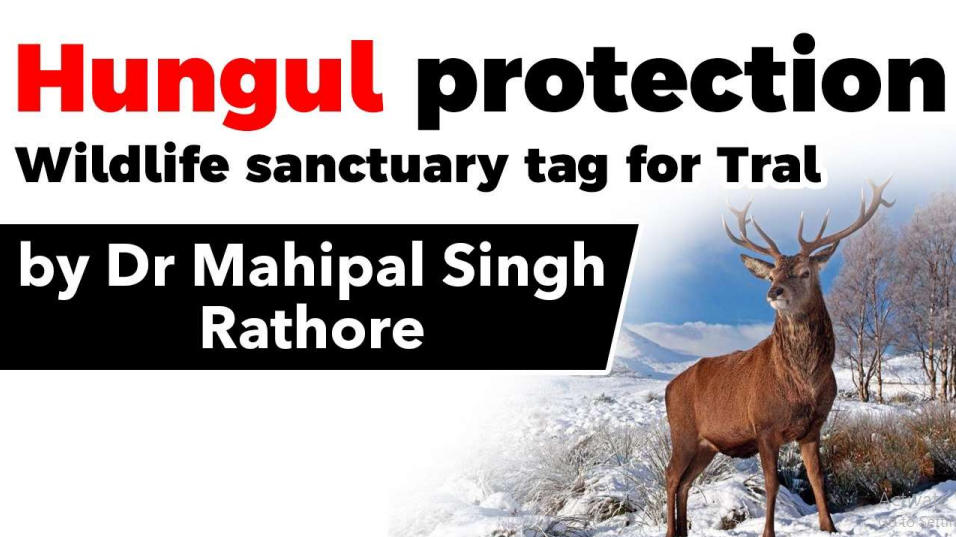Table of Contents
Why in news?
- The Jammu and Kashmir administration has declared an area of 154.15 square kilometres in south Kashmir as the Tral Wildlife Sanctuary for the conservation of the critically endangered Hangul or Kashmir stag.
Kashmir Stag (Hangul)
- Cervus canadensis hanglu
- Hangul, the state animal of Jammu& Kashmir, is restricted to the Dachigam National Park near Srinagar.**
- The Hangul is placed under Schedule I of the Indian Wildlife(Protection) Act, 1972 and the J&K Wildlife Protection Act, 1978.


- The Hangul was once widely distributed in the mountains ofKashmir and parts of Chamba district in neighbouring Himachal Pradesh.
- The IUCN’s Red List has classified it as Critically Endangeredand is similarly listed under the Species Recovery Programme of the Wildlife Institute of India (WII) and the Environmental Information System (ENVIS) of the MoEFCC.
Q. Which other species from Jammu and Kashmir are were critically endangered The IUCN Red Data Book?

- Hangul is part of the Asian group of the elk
- The Hangul is considered equally significant to the state ofJammu & Kashmir as the tiger is to the whole of India.
- From a population of 5,000 in the early 1900s, the Hangul’snumbers have constantly declined over the decades.
- 2017 – the population of Hangul is 182 in Dachigam andadjoining areas.
Challenges
- The biggest challenges which have been identified by experts in the way of conservation and population growth of Hangul are
- Habitat fragmentation
- very low fawn-female ratio.
- male-female disparity
- Predation of fawns by the Common Leopard, the Himalayan Black Bear and nomads’ dogs.
- Influx of livestock herds of nomadic communities in the Dachigam National Park
- After the closing down of their traditional routes leading to over a dozen alpine pastures (in Gurez) by the army after the inception of armed conflict in Kashmir, nomads have not been able to graze their herds in those pastures.
- So, they are taking their large herds of livestock to the upper reaches of Dachigam during summers.
- Today Dachigam National Park is surrounded by many conservation reserves which are contiguous to the boundaries.
- There are many villages which are located on the periphery of Dachigam where managing wildlife have become challenging task.
Relic populations
- Hanguls migrated over long distances for pastures
- Restriction of territory – low population
- Tral Wildlife Sanctuary – To connect south corridor of Hangul landscape with north corridor.
- This will address Hangul inbreeding and relic population will reach the main population so that genetic inbreeding can be addressed.



Tral Wildlife Sanctuary
- Tral WS will come into being by merging Changed, PanyarShikargah and Khiram wildlife conservation reserves and fewforest compartments of Awantipora Forest Division.
- The sanctuary will function as a protected wildlife corridorfor relic Hangul population present down south in ShikargahPanyer and Khiram conservation reserves with main population found in Dachigam
- Conservation reserves and community reserves are terms denoting protected areas which typically act as buffer zones to or connectors and migration corridors between established national parks, wildlife sanctuaries and reserved and protected forests .
- Community reserves – On land of private or community ownership, if a group of people are doing conservation work and Government gives it a legal recognition
- Conservation reserves – are government owned land.
- In both the cases conservation efforts are by local community only.
Critically endangered
- Markhor —world’s largest species of wild goat found in Kashmir and central Asia.
- Chiru – The Tibetan antelope

Latest Burning Issues | Free PDF






















 WhatsApp
WhatsApp